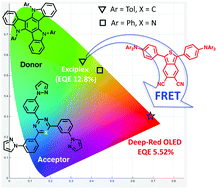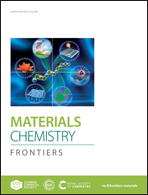New exciplex systems composed of triazatruxene donors and N-heteroarene-cored acceptors†
Abstract
In this study, three triazatruxene-based molecules Tr-Me, Tr-Ph, and Tr-Tol with methyl, phenyl, and p-tolyl pendant groups, respectively, were intermixed with three acceptors 3P-T2T, 3P-T2P, and 3P-Pyr featuring phenylpyrazole peripherals and triazine, pyrimidine, and pyridine cores, respectively, to generate an array of nine blends to probe the feasibility of formation of an exciplex. The observed red-shifted emission compared to those of pristine donor and acceptor films is a good indication of exciplex formation. The exciplex emissions are mainly modulated by the features of N-heteroarene cores of acceptors, while the HOMOs of the donors are less influenced by the substituents. From the screening of these D:A combinations it was concluded that four exciplex-forming blends composed of Tr-Ph and Tr-Tol as donors and 3P-T2T and 3P-T2P as acceptors exhibit promising properties suitable for OLED applications. Among them, a green device employing a Tr-Tol:3P-T2P blend as the emitting layer performed with the best efficiency with a maximum external quantum efficiency (EQEmax) of up to 12.8%. These new exciplex-forming systems were further explored as cohosts for a newly developed fluorescent emitter (DT)2BTh2CN. The Tr-Ph:3P-T2P blend was found to serve as the best host to give a deep-red (EL λmax 671 nm, CIE (0.68, 0.31)) OLED device with an EQEmax of 5.52%. The data extracted from the transient photoluminescent studies shed light on the emission mechanism which is dominated by Förster energy transfer and simultaneously suffers from competing Dexter energy transfer quenching. Our results highlight the feasibility of using triazatruxene as the donor for exciplex formation as well as the tunability of the emission wavelength of exciplex-forming systems by rational structural modifications of both donors and acceptors.

- This article is part of the themed collection: Emerging Organic Electronics


 Please wait while we load your content...
Please wait while we load your content...